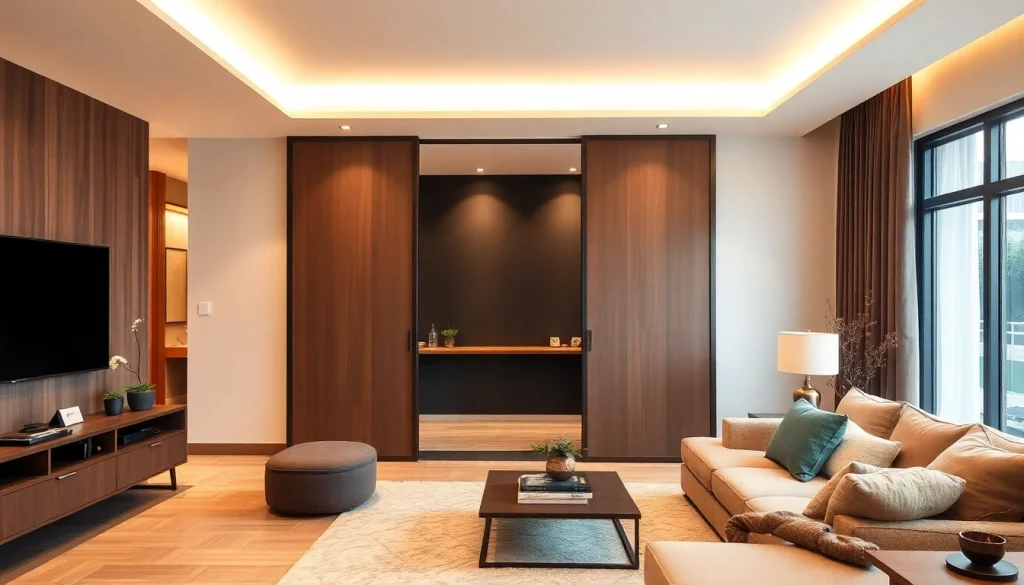Introduction to Sliding Partition Walls
In modern living and working environments, the quest for flexible space has led to increasing popularity for innovative solutions like sliding partition walls. These functional installations not only enhance aesthetic appeal but also provide practical solutions for space management. Whether you are reimagining your home layout or seeking efficient ways to partition commercial spaces, sliding partition walls can be the perfect solution. Through this comprehensive guide, we will explore different aspects of sliding partition walls, including their benefits, types, installation processes, design inspirations, and maintenance tips.
What Are Sliding Partition Walls?
Sliding partition walls are versatile panels designed to divide spaces in an adjustable manner, allowing areas to be opened up or closed off based on current needs. Unlike traditional fixed walls, sliding partitions can move horizontally along a track system, making them ideal for both temporary and permanent installations.
Benefits of Using Sliding Partition Walls
Space Optimization
One of the primary advantages of sliding partition walls is their ability to optimize space. They allow for the creation of multifunctional areas that can be adapted depending on whether you need an open concept or a more divided environment.
Flexibility and Convenience
Sliding partition walls provide unmatched flexibility. They can be easily moved to create privacy or open spaces, a feature that is particularly beneficial in homes with changing needs or commercial areas that require frequent reconfiguration.
Aesthetic Appeal
Modern sliding partitions come in various materials and designs, contributing significantly to a room’s aesthetic. From elegant glass panels that promote light flow to rustic wooden designs that add character, the appeal of sliding partitions is evident.
Cost-Effectiveness
In many cases, sliding partition walls can be a cost-effective alternative to major renovations. They do not require extensive construction work and can often be installed quickly, reducing labor costs.
Common Applications in Residential and Commercial Spaces
Residential Use
In residential settings, sliding partition walls can be employed to separate living rooms from dining spaces, create makeshift offices in small apartments, or even divide children’s play areas from adult spaces.
Commercial Use
In commercial buildings, these walls can be used in offices to create private meeting rooms or collaborative workspaces. They are also advantageous in hotels for room customization based on occupancy needs.
Types of Sliding Partition Walls
Wall-Mounted Versus Ceiling-Mounted Systems
Sliding partition walls come in two primary configurations: wall-mounted systems, which are fixed to one wall and slide along the track, and ceiling-mounted systems that offer the advantage of being track-free on the floor. This ceiling-mounted option is increasingly popular for accessibility and clean aesthetic purposes.
Material Options: Glass, Wood, and More
These walls can be constructed from a variety of materials, including glass, wood, fabric, and metal. Glass panels are particularly popular in contemporary designs for their ability to create a sense of space while allowing natural light to flow through. Wooden partitions, on the other hand, bring warmth and texture.
Customizable Features to Enhance Functionality
Sliding partition walls can be highly customizable. Features such as integrated soundproofing, electronic operation for easy movement, and added insulation can enhance functionality based on specific requirements.
Installation of Sliding Partition Walls
Step-by-Step Installation Guide
Installing a sliding partition wall involves several steps:
- Measure the Space: Accurately measure the area to determine the size of the wall needed.
- Select the System: Choose between wall-mounted or ceiling-mounted based on your preference.
- Gather Materials: Ensure you have all necessary materials, including wall panels, tracks, and hardware.
- Install Tracks: Secure the track system according to the manufacturer’s specifications.
- Install the Panels: Hang the panels on the tracks, ensuring they slide smoothly.
- Finishing Touches: Add any additional features, such as soundproofing or decorative elements.
Tools Required for DIY Installation
For those choosing to install sliding partition walls themselves, essential tools may include:
- Measuring tape
- Drill
- Screws and anchors
- Level
- Stud finder
- Hand saw or circular saw for custom sizing
Hiring Professionals Versus DIY
Although DIY installation can be rewarding and cost-effective, hiring professionals may ensure that the installation is done correctly and quickly. Assess your skill level, the complexity of the installation, and the potential for adjustments before deciding.
Design Inspiration for Sliding Partition Walls
Visual Styles: Minimalist, Rustic, and Modern
Each design style has unique charm and functionality when it comes to sliding partition walls. Minimalist designs often use neutral colors and simple lines, while rustic styles might incorporate reclaimed wood and natural finishes. Modern designs may favor sleek glass panels and bold color contrasts.
How to Integrate Sliding Partition Walls into Your Decor
Integrating these walls into your existing décor can enhance a space’s overall harmony. Consider utilizing colors, materials, and themes that complement other fixtures in the area.
Examples from Real-Life Installations
Real-life installations offer the best insights into how sliding partition walls perform in various spaces. For example, many urban apartments have successfully employed glass sliding partitions to create flexibility while maintaining openness.
Maintenance and Care for Sliding Partition Walls
Regular Maintenance Tips
To prolong the life of sliding partition walls, regular maintenance is essential. This includes cleaning tracks, lubricating moving parts, and checking for any alignment issues.
Common Issues and Troubleshooting
Common challenges with sliding partition walls include sticking or misaligned panels. These problems can often be resolved with minor adjustments to the track or wheel system.
When to Consider Upgrading Your Partition Wall
If your existing partition wall is showing signs of wear, does not meet functionality requirements, or lacks aesthetic appeal, it might be time to explore upgrading to a new model that better fits your needs.
You may also like
-
Expert Landscaping Contractor Coquitlam: Quality Services for Your Outdoor Space
-
Expert Tips for Kitchen Remodeling Palm Springs: Transform Your Space Today
-
Essential Guide to Roof Repair Vancouver Wa: Ensuring Long-Lasting Protection
-
Expert Landscaping Contractor Coquitlam: Your Partner in Outdoor Excellence
-
Effective Mold Remediation Strategies for Homes and Businesses
